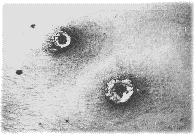The term "cancer" is a broad, generic term used to describe an estimated 200 different kinds of malignant growths, or "neoplasms." "Cancer" means "crab" in Latin (earlier, from the Greek word "karkinos") and the term describes the great veins or tentacle-like structures that surround these growths, which appeared to the ancients to look like the claws of a crab.
(1) Clonality - cancer cells originate from genetic changes in a single cell, which then multiplies to form a clone of malignant cells. (2) Autonomy: Cancerous growth is not controlled or regulated by the normal biochemical and physical forces present in the body, (3) Metastatis - Cancer cells are able to grow in the parts of the body other than their site of origin. The process by which normal cells develop into cancer cells is called "malignant transformation," and (4) Anaplasia - The abnormally growing cells do not develop into normal cells similar to the one from which the clone arose.
(1) Change in bowel or bladder habits;
(2) A sore that does not heal;
(3) Unusual bleeding or discharge;
(4) Thickening or lump in breast or elsewhere;
(5) Indigestion or difficulty in swallowing;
(6) Obvious change in a wart or mole;
(7) Nagging cough or hoarseness.
If any of these warning signs manifests, you should seek your physician's attention as soon as possible.
 Cancer
Cancer|
To U.S. Users: None of the
products mentioned on this page have been evaluated by the U.S. Food
& Drug Administration. Therefore, none of them are intended to
diagnose, treat, cure, or prevent any disease. The material on this
page is for educational and research purposes only.
|

Note: This information is
provided for educational purposes only and is not intended to replace the
use of a qualified health care professional. We strongly recommend the use
of a physician for the diagnostic phase of any treatment. With an accurate
diagnosis in hand, we believe the consumer, at that point, has a basic,
unalienable right to seek out factual information on all therapeutic
approaches, both orthodox and alternative, and choose those approach(es)
that are right for them. Nonetheless, a "good doctor" should be considered
a requisite starting point.
|
CANCER DIAGNOSIS
|